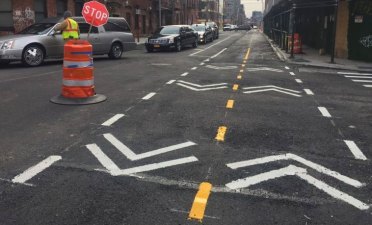Greenpoint Gets a Preview of Brooklyn Waterfront Greenway on West Street

NYC DOT and consultants for the Department of Design and Construction gave Greenpoint residents a glimpse of preliminary designs for the West Street segment of the Brooklyn Waterfront Greenway Wednesday night at a full meeting of Brooklyn Community Board 1. The two-way bikeway proposed for West Street is the first of 23 capital projects that will eventually comprise the finished, 14-mile greenway.
While CB 1 voted in 2008 to support a similar redesign of Kent Avenue (a preliminary segment in the greenway), the current board seems to have regressed since then, and residents who support the project shouldn’t take anything for granted. At Wednesday’s meeting, the fundamental premise of establishing a two-way bike lane on the street received some support from the audience, but also a hostile response from the transportation committee chair.
For motor traffic, the plan would convert the length of West Street, currently two-way, to one-way northbound. Approximately 80 parking spaces on the west side of the street would be replaced with a two-way bike lane, separated from motor vehicle traffic by a mountable curb.
A mountable curb is not what Milton Puryear of the Brooklyn Greenway Initiative would have preferred for West Street. “It’s not ideal,” he said, noting that the he often encounters parked cars on the Sands Street bike path, which has a mountable curb. While the proposed design will be open to similar incursions, Puryear said, it will be “way better than the way it is.”
A four-foot painted buffer will extend beyond the mountable curb, and in the center of the roadway auto and truck traffic will have a wide, 17-foot travel lane.
The project would maintain 15-foot wide sidewalks on each side of the street, adding a planted buffer between the west sidewalk and the bike lane. In the current design, the buffer would treat stormwater runoff from the sidewalk but not the roadway. The Brooklyn Greenway Initiative’s stormwater study for West Street outlined a more robust plan than was presented on Wednesday, though Linda Reardon of the RBA Group, a DDC consultant, said that the stormwater plan for the street is subject to change.
Karen Nieves, a transportation committee member and employee of North Brooklyn industry group EWVIDCO, said that she would like to see businesses more thoroughly consulted as the design progresses. “Some businesses think this will kill them and they’ll have to move,” she said. Reardon assured her that RBA had mapped truck turns from driveways along West Street and that the design would not hinder commercial trucks.
The greenway project in North Brooklyn used to have a champion in the CB 1 transportation committee chair: Teresa Toro helped lead a lengthy public process for the Kent Avenue segment that resolved points of contention. But that no longer seems to be the case with the current transportation committee chair, Wilfredo Florentino, who issued the most hostile words of the night. Florentino said that his committee had “gotten a lot of comments from the community in opposition to the plan.” He asked Wright if the city would consider abandoning the project entirely in the face of opposition. “This plan is moving forward, regardless of the community’s position?” Florentino asked.
“That’s absolutely not what I said,” Wright replied. “DOT and DDC will try to work with the community if they have issues.” Florentino did not seem satisfied, but other locals at the meeting were more interested in hashing out the details of the project than standing in the way.
Barbara Vetell of the Greenpoint West Street Block Association said that she initially opposed the project because she wanted the funds to be spent on other things. But after seeing that the money cannot be diverted, she said, “I’m going to support it.” Vetell said that she wants to ensure that DDC works with community members and keeps its promises.
One concern for her is the wider travel lane for cars and trucks. “It’s going to turn into a speedway,” she said. “They really need to slow that traffic down.”
